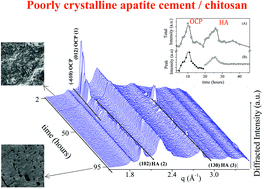In this study, the real-time monitoring of structural changes, occurring upon poorly crystalline apatite bone cement hardening in the presence of chitosan, simulated body fluid and human blood, was performed. Strong experimental evidence of octacalcium phosphate intermediate phase is provided. The energy dispersive X-ray diffraction was applied in situ to monitor the structural changes upon the transformation process, while the Fourier transform infrared spectroscopy and the scanning electron microscopy supplied information on the vibrational and morphological properties of the system. The cooperative action of chitosan and simulated body fluid induces the formation of a preferentially oriented hydroxyapatite phase, this process being similar to the oriented self-assembling process in collagen-apatite matrix in human plasma, occurring upon in vivo biomineralization. Conversely, the presence of blood does not induce any significant change in hardening kinetics and the final structure of the investigated cement.

You have access to this article
 Please wait while we load your content...
Something went wrong. Try again?
Please wait while we load your content...
Something went wrong. Try again?


 Please wait while we load your content...
Please wait while we load your content...